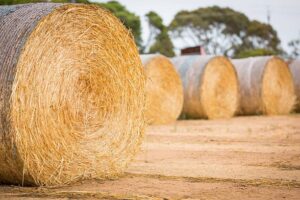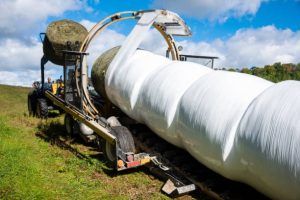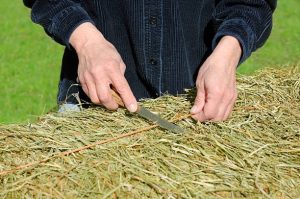Whether you’re a farmer, gardener, or just someone looking to learn more about the world around them, understanding baling twine is an essential skill. This seemingly simple tool is crucial in agriculture and has become a staple in many industries and households. This comprehensive guide will delve into baling twine, its various uses, and the different types available on the market today. Whether you have been using it for years or are entirely new, this article will provide valuable insights that will deepen your knowledge and elevate your use of straw baling twine.
Baling twine may seem like a small and simple piece of equipment, but its importance in the farming industry cannot be underestimated. This strong and durable cord ties and holds hay or straw bales together, making transportation and storage much easier. Farmers rely on baling twine to secure their harvests and save time and resources.
 Choosing the right baling twine can make all the difference in baling hay. Several types of twine are available, each with unique features and benefits. First, there’s sisal twine, made from natural fibres and biodegradable. It’s ideal for small square bales and is gentle on animals that might accidentally consume it. Polypropylene twine, on the other hand, is synthetic and much stronger than sisal. It’s perfect for bigger bales and can withstand harsh weather conditions. Then there’s the most advanced option – baling net wrap. This web-like material provides unmatched coverage and ensures that hay is secure even during transport.
Choosing the right baling twine can make all the difference in baling hay. Several types of twine are available, each with unique features and benefits. First, there’s sisal twine, made from natural fibres and biodegradable. It’s ideal for small square bales and is gentle on animals that might accidentally consume it. Polypropylene twine, on the other hand, is synthetic and much stronger than sisal. It’s perfect for bigger bales and can withstand harsh weather conditions. Then there’s the most advanced option – baling net wrap. This web-like material provides unmatched coverage and ensures that hay is secure even during transport.
If you frequently use straw baling twine, you know how important it is to store it properly to extend its lifespan. The key to keeping your twine in good condition is to store it in a cool and dry place, away from any moisture or direct sunlight. This will help prevent the twine from becoming brittle or rotting over time. Keep your baling twine neatly coiled or wound up to prevent it from becoming tangled or snagged on any objects.
Baling twine is common on farms and ranches to hold hay, straw, or other crops together. But what do you do with the old or used twine? Instead of throwing it away, there are many creative ways that you can repurpose it. One idea is to use it as garden ties to support plants and vines. You can also weave it into mats or rugs or even use it to make baskets. Twine can even be used to create decorative wall art or to add texture to a homemade dreamcatcher. With some imagination and creativity, your old baling twine can be turned into something new and valuable.
Choosing the right size and strength of baling twine is essential for efficient and safe use. There are several factors to consider when it comes to straw baling twine. Firstly, you need to match the strength of the twine to the weight of the bales you’re creating. Secondly, you must consider whether you need to make round or square bales. The size and shape of your bales will determine the length and thickness of twine you require. Selecting weather-resistant baling twine is vital to prevent it from breaking down prematurely. By considering all these factors, you can find the right size and strength of baling twine to suit your specific needs and ensure successful baling every time.
Baling twine may seem like a harmless tool, but it can cause severe injuries if not handled properly. Always wear protective gear such as gloves and goggles to maintain safety while using baling twine. Proper cutting techniques should also be employed to avoid potential cuts or abrasions. Be sure to dispose of the twine in a designated bin to prevent livestock or other wildlife from ingesting it. By taking these simple precautions, you can ensure that baling twine remains a valuable tool for your farming needs without causing any harm to yourself or the environment.
Baling twine is undoubtedly at the top of the list of versatile and valuable tools for farmers. This seemingly simple product can be used on the farm, from tying up crops to securing equipment. Its strength and durability make it a go-to resource for those in the agriculture industry. It’s also an eco-friendly option, as many types of baling twine are made from biodegradable materials. Whether you’re a seasoned farmer or just starting, a baling twine is a must-have tool in your agriculture arsenal.

 Depending on the farmer’s needs, various silage wraps are on the market. Some of the top brands include EconoFlex, Silacord, and Tytan. These films are made with high-quality materials and provide superior strength and durability. In addition, they can be used on both square and round bales.
Depending on the farmer’s needs, various silage wraps are on the market. Some of the top brands include EconoFlex, Silacord, and Tytan. These films are made with high-quality materials and provide superior strength and durability. In addition, they can be used on both square and round bales. While sisal and cotton baler twine are both biodegradable, cotton twine is the least biodegradable twine choice. Sisal twine is a natural fibre that is resistant to rot and mildew. Solar-degradable twine is treated and lasts a lot longer than traditional twine. It also costs half as much as regular twine. Whether you choose cotton twine or sisal twine, biodegradability is important in your decision.
While sisal and cotton baler twine are both biodegradable, cotton twine is the least biodegradable twine choice. Sisal twine is a natural fibre that is resistant to rot and mildew. Solar-degradable twine is treated and lasts a lot longer than traditional twine. It also costs half as much as regular twine. Whether you choose cotton twine or sisal twine, biodegradability is important in your decision.